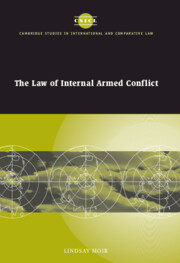Book contents
- Frontmatter
- Contents
- Preface and acknowledgements
- Table of cases
- Table of treaties and other international instruments
- 1 The historical regulation of internal armed conflict
- 2 Article 3 common to the Geneva Conventions
- 3 Additional Protocol II of 1977
- 4 Customary international law and internal armed conflict
- 5 Human rights during internal armed conflict
- 6 Implementation and enforcement of the laws of internal armed conflict
- Bibliography
- Index
- CAMBRIDGE STUDIES IN INTERNATIONAL AND COMPARATIVE LAW
4 - Customary international law and internal armed conflict
Published online by Cambridge University Press: 07 July 2009
- Frontmatter
- Contents
- Preface and acknowledgements
- Table of cases
- Table of treaties and other international instruments
- 1 The historical regulation of internal armed conflict
- 2 Article 3 common to the Geneva Conventions
- 3 Additional Protocol II of 1977
- 4 Customary international law and internal armed conflict
- 5 Human rights during internal armed conflict
- 6 Implementation and enforcement of the laws of internal armed conflict
- Bibliography
- Index
- CAMBRIDGE STUDIES IN INTERNATIONAL AND COMPARATIVE LAW
Summary
The primary legal bases for the regulation of internal armed conflicts are the conventional rules contained in common Article 3 and Additional Protocol II. During the drafting process of Additional Protocol II there had been a reluctance to accept that any customary rules existed regulating internal armed conflict, and the Martens Clause contained in the Preamble to Protocol II differs from that in Article 1(2) of Protocol II in that it makes no reference to ‘the principles of international law derived from established custom’. This has been explained as being due to the fact that ‘the attempt to establish rules for a non-international armed conflict only goes back to 1949 and that the application of common Art. 3 in the practice of States has not developed in such a way that one could speak of “established custom” regarding non-international conflicts’.
Meron has nevertheless argued that Additional Protocol II contains a basic core of human rights, many of which have already been accepted as representing customary international law in human rights instruments, and which should therefore continue to have customary law status when stated in humanitarian law instruments. Meron has also argued that the failure of the Diplomatic Conference to agree any ‘Hague Law’ principles for internal conflicts meant that such hostilities would have to be tempered through the advancement of customary law alone, the primary source for which should be principles of humanity.
- Type
- Chapter
- Information
- The Law of Internal Armed Conflict , pp. 133 - 192Publisher: Cambridge University PressPrint publication year: 2002



